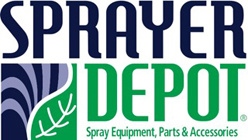You own a sprayer. It’s pretty important to your profession. You work in the lawn/landscape, pest control, agricultural, golf/recreation, or horticultural industries. You know how to spray. You’re smart. You understand what components are needed to get the optimal pressure from your equipment or how that simple little o-ring can make or break your day. Does that description sound familiar? Any pro who has been spraying for five to 30 years and more will understand that as technology in this field advances, so do your own tips and tricks of the trade.
pest control, agricultural, golf/recreation, or horticultural industries. You know how to spray. You’re smart. You understand what components are needed to get the optimal pressure from your equipment or how that simple little o-ring can make or break your day. Does that description sound familiar? Any pro who has been spraying for five to 30 years and more will understand that as technology in this field advances, so do your own tips and tricks of the trade.
Here we’ll share five tried and true things you should avoid when setting up your sprayer for the day, for the season or even for the first time. We’re talking routine tips you likely do every day that you use your sprayer, as well as a few deal breakers we’d be remiss if we didn’t share. So consider this more of a checklist, than an instruction manual as you beat the heat today.
1.) Know your nozzle. From using the right tip for your application needs, to understanding how to clean it properly, knowing your nozzle is key. By now you know which tip offers the optimal performance, which spray pattern works best for your needs, and how to check flow rates. But as new technology comes to market and we’re better able to control drift or other outside forces, don’t forget the simple information from this buying guide for spray tips that can make all the difference for your season.
2.) Clean your equipment. Yes, this is a given, but a factor that often gets overlooked when you’re tired from a long day or running behind to get home for dinner. However, cleaning your sprayer after each use can take mere minutes compared to the hours you’ll spend cleaning build-up the next day – or worse if the next time you use it is weeks or months away. Once you’ve cleaned your sprayer, take a few extra minutes to calibrate your sprayer for optimal spraying and you’ll be happier the next time you’re ready to use it.
3.) Check your tire pressure. If you’re sporting a two- or four-wheel sprayer or even one that’s mounted to the bed of your truck, operating with the correct tire pressure is important for a smooth ride and sprayer stability. Be sure to check the tire pressure of your rig against the manufacturer’s recommendation. After all, tires act as both a spring and shock absorber so running with tire pressure too high can reduce traction and amplify any surface irregularities. That’s the last thing you want to deal with when you start spraying. To that end, if you’re using a smaller handheld or backpack sprayer the same tools apply – check the shoulder straps for a secure fit and wear the right shoes for that added spring in your step.
4.) Watch the weather.Whether you’re concern is 100 degree heat or that thunderstorm brewing just west of your location, watching the weather will make all the difference as you plan for your day. For more on watering tips and the weather, check out our recent post on water use and 5 tips for smart spraying. We know with the drought watches and warnings our friends in California are all over this one!
5.) Don’t settle for mediocre. Have pride in the equipment you own and if something’s not working properly or not the best fit for your needs, don’t settle. Doing so could not only negatively impact your work, but also could lead to added frustration or longer work hours. Cut yourself some slack and don’t settle for anything less than the best. Spraying shouldn’t be a chore, have some fun with it and that means not settling for anything less than what’s best for your usage.
So there you have it. Now it’s your turn to share. What are your tried and true tips and tricks of the spraying trade? Share them in the comments below, on Facebook or Twitter.

.png?width=280&name=SameDayShippingGuarantee-New%20(1).png)




